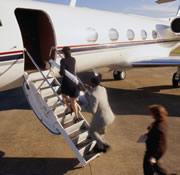 All aboard: a rush for the window seats might be the quickest way to get everyone on the plane.© Getty
All aboard: a rush for the window seats might be the quickest way to get everyone on the plane.© GettyBudget airlines' 'free boarding' policies may produce an indecorous scramble for seats, but don't be too quick to grumble. According to a team of computer scientists and mathematicians, this is one of the most efficient ways to board passengers.
Boarding from the back rows first - typical in classier airlines - is much less efficient. As experience tells us, boarders are frequently held up while those ahead of them block the aisles.
"Back-to-front boarding is bad because it is designed for cardboard-thin passengers, or for the spacious surroundings of the first-class compartment", explains Eitan Bachmat of Ben-Gurion University in Israel.
But finding better boarding strategies is tough. So tough, in fact, that Bachmat and his colleagues were forced to use mathematics more commonly applied to the theory of relativity and prime number theory1.
Relative benefits
Airlines are keen to cut boarding times, because they often determine how quickly a plane can be turned around for another flight. But since 1970, boarding times have been steadily increasing.
“Back-to-front boarding is designed for cardboard-thin passengers.”
Eitan Bachmat
Ben-Gurion University, Israel.
To try to improve the efficiency of the boarding process, aerospace companies such as Boeing use computer simulations in which each passenger takes their seat after performing activities such as helping family members and stowing carry-on luggage.
Bachmat and colleagues, in contrast, have posed the problem in terms of permutations: the different orders in which passengers might board, which determines your chances of getting blocked by someone seated closer to the door.
The mathematics of permutations gets pretty hairy, involving concepts such as 'two-dimensional Lorentz geometry' and 'random matrix theory' that are likely to boggle airline companies.
"Lorentzian geometry was invented for the sole purpose of describing relativity theory", says Bachmat. "This seems to be the first application of this theory outside physics."
Window or aisle?
The researchers say that their model predicts boarding times similar to those given by simulations - even though the latter include complicating factors such as slow-moving passengers, full overhead bins, and people sitting in the wrong place.
And their model doesn't demand detailed assumptions about the size and shape of an aircraft. Instead, it depends primarily on the seating plan. "If you wanted to design a plane for easy boarding, our model would be easier to apply", says Bachmat's colleague Steve Skiena of the State University of New York at Stony Brook.
ADVERTISEMENT
The researchers find that boarding passengers with window seats first is more efficient than filling the plane from the back, which creates a lot of blocking. Uncontrolled boarding - adopted by airlines such as Southwest in the United States and EasyJet in the UK - is also relatively efficient.
Most efficient of all would be to avoid all blocking by boarding passengers in a strict sequence, seat by seat. But most people don't like to be controlled to that extent, says Skiena. "Airlines would like to turn around their planes as quickly as possible", he says. "But they don't want to annoy their passengers."
Ben-Gurion University, Israel.
-
References
- Bachmat E., et al. Preprint http://www.arxiv.org/abs/physics/0512020 (2005).
